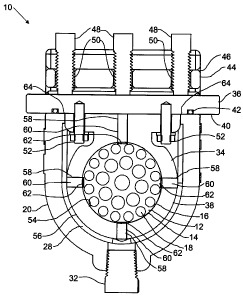Une partie des informations de ce site Web a été fournie par des sources externes. Le gouvernement du Canada n'assume aucune responsabilité concernant la précision, l'actualité ou la fiabilité des informations fournies par les sources externes. Les utilisateurs qui désirent employer cette information devraient consulter directement la source des informations. Le contenu fourni par les sources externes n'est pas assujetti aux exigences sur les langues officielles, la protection des renseignements personnels et l'accessibilité.
L'apparition de différences dans le texte et l'image des Revendications et de l'Abrégé dépend du moment auquel le document est publié. Les textes des Revendications et de l'Abrégé sont affichés :
| (12) Brevet: | (11) CA 2675542 |
|---|---|
| (54) Titre français: | CARTER POUR CONDITIONNEUR D'ECOULEMENT |
| (54) Titre anglais: | HOUSING FOR A FLOW CONDITIONER |
| Statut: | Octroyé |
| (51) Classification internationale des brevets (CIB): |
|
|---|---|
| (72) Inventeurs : |
|
| (73) Titulaires : |
|
| (71) Demandeurs : |
|
| (74) Agent: | WOODRUFF, NATHAN V. |
| (74) Co-agent: | |
| (45) Délivré: | 2014-04-01 |
| (22) Date de dépôt: | 2009-08-19 |
| (41) Mise à la disponibilité du public: | 2011-02-19 |
| Requête d'examen: | 2011-06-14 |
| Licence disponible: | S.O. |
| (25) Langue des documents déposés: | Anglais |
| Traité de coopération en matière de brevets (PCT): | Non |
|---|
| (30) Données de priorité de la demande: | S.O. |
|---|
L'invention porte sur un boîtier pour dispositif de conditionnement d'écoulement. Le boîtier comprend un corps comprenant un premier et un deuxième raccord de tuyau, un passage d'écoulement entre les raccords de tuyau, une cavité de réception de support dans le passage d'écoulement et une ouverture correspondant à la cavité de réception de support. Un porte-disques comporte une partie étanchéité et une partie support de dispositif de conditionnement d'écoulement. La partie étanchéité comporte une surface d'étanchéité pour étanchéifier l'ouverture correspondant à la cavité de réception de support et la partie support du dispositif de conditionnement d'écoulement dépend de la partie étanchéité. La partie support du dispositif de conditionnement d'écoulement est dimensionnée de manière à pouvoir s'insérer à travers l'ouverture et dans la cavité de réception de support, et comporte une pluralité d'ouvertures de réception de vis de calage ou une lèvre de retenue pour fixer le dispositif de conditionnement d'écoulement. Un connecteur permet de fixer le porte-disques dans le corps de manière que la surface d'étanchéité s'étanchéifie contre le corps.
There is provided a housing for a flow conditioner. The housing comprises a body having first and second pipe connections, a flow passage between the pipe connections, a carrier receiving cavity within the flow passage, and an opening corresponding to the carrier receiving cavity . A plate carrier has a sealing portion and a flow conditioner carrying portion. The sealing portion has a sealing surface for sealing the opening corresponding to the carrier receiving cavity , and the flow conditioner carrying portion depends from the sealing portion. The flow conditioner carrying portion is sized to be inserted through the opening and into the carrier receiving cavity, and has a plurality of set screw receiving apertures or a retaining lip for securing the flow conditioner. There is a connector for securing the plate carrier within the body such that the sealing surface seals against the body.
Note : Les revendications sont présentées dans la langue officielle dans laquelle elles ont été soumises.
Note : Les descriptions sont présentées dans la langue officielle dans laquelle elles ont été soumises.

Pour une meilleure compréhension de l'état de la demande ou brevet qui figure sur cette page, la rubrique Mise en garde , et les descriptions de Brevet , États administratifs , Taxes périodiques et Historique des paiements devraient être consultées.
| Titre | Date |
|---|---|
| Date de délivrance prévu | 2014-04-01 |
| (22) Dépôt | 2009-08-19 |
| (41) Mise à la disponibilité du public | 2011-02-19 |
| Requête d'examen | 2011-06-14 |
| (45) Délivré | 2014-04-01 |
Il n'y a pas d'historique d'abandonnement
Dernier paiement au montant de 263,14 $ a été reçu le 2023-07-06
Montants des taxes pour le maintien en état à venir
| Description | Date | Montant |
|---|---|---|
| Prochain paiement si taxe applicable aux petites entités | 2024-08-19 | 253,00 $ |
| Prochain paiement si taxe générale | 2024-08-19 | 624,00 $ |
Avis : Si le paiement en totalité n'a pas été reçu au plus tard à la date indiquée, une taxe supplémentaire peut être imposée, soit une des taxes suivantes :
Les taxes sur les brevets sont ajustées au 1er janvier de chaque année. Les montants ci-dessus sont les montants actuels s'ils sont reçus au plus tard le 31 décembre de l'année en cours.
Veuillez vous référer à la page web des
taxes sur les brevets
de l'OPIC pour voir tous les montants actuels des taxes.
Les titulaires actuels et antérieures au dossier sont affichés en ordre alphabétique.
| Titulaires actuels au dossier |
|---|
| CLARK, DEROLD G. |
| Titulaires antérieures au dossier |
|---|
| S.O. |